 Open Access
Open Access
ARTICLE
Feature-Based Augmentation in Sarcasm Detection Using Reverse Generative Adversarial Network
1 Computer Science Department, School of Computer Science, Bina Nusantara University, Jakarta, 11480, Indonesia
2 Cyber Security Program, Computer Science Department, School of Computer Science, Bina Nusantara University, Jakarta, 11480, Indonesia
* Corresponding Author: Derwin Suhartono. Email:
Computers, Materials & Continua 2023, 77(3), 3637-3657. https://doi.org/10.32604/cmc.2023.045301
Received 23 August 2023; Accepted 27 November 2023; Issue published 26 December 2023
Abstract
Sarcasm detection in text data is an increasingly vital area of research due to the prevalence of sarcastic content in online communication. This study addresses challenges associated with small datasets and class imbalances in sarcasm detection by employing comprehensive data pre-processing and Generative Adversial Network (GAN) based augmentation on diverse datasets, including iSarcasm, SemEval-18, and Ghosh. This research offers a novel pipeline for augmenting sarcasm data with Reverse Generative Adversarial Network (RGAN). The proposed RGAN method works by inverting labels between original and synthetic data during the training process. This inversion of labels provides feedback to the generator for generating high-quality data closely resembling the original distribution. Notably, the proposed RGAN model exhibits performance on par with standard GAN, showcasing its robust efficacy in augmenting text data. The exploration of various datasets highlights the nuanced impact of augmentation on model performance, with cautionary insights into maintaining a delicate balance between synthetic and original data. The methodological framework encompasses comprehensive data pre-processing and GAN-based augmentation, with a meticulous comparison against Natural Language Processing Augmentation (NLPAug) as an alternative augmentation technique. Overall, the F1-score of our proposed technique outperforms that of the synonym replacement augmentation technique using NLPAug. The increase in F1-score in experiments using RGAN ranged from 0.066% to 1.054%, and the use of standard GAN resulted in a 2.88% increase in F1-score. The proposed RGAN model outperformed the NLPAug method and demonstrated comparable performance to standard GAN, emphasizing its efficacy in text data augmentation.Keywords
Interpretation of a statement is crucial to determine the results of the analysis. Meanwhile, the results of the proper analysis based on data lead to the right action. Currently, there is an abundance of information being shared on social media platforms in the form of statements, thoughts, or comments. These expressions encompass both positive and negative sentiments. However, it is within this spectrum of statements that negative sentiments are occasionally veiled through the use of sarcasm. Sarcastic remarks, by nature, contain an implied message, rendering them more challenging to decipher.
Sarcasm, as defined, is a form of negative sentiment concealed within seemingly pleasant sentences [1]. Recent studies have further categorized sarcasm as an aggressive variant of irony used to convey unfavorable messages [2]. It is often intertwined with various forms of irony [3]. Sarcasm can manifest through both verbal and textual communication. Verbal sarcasm carries distinct characteristics such as volume, speaking tempo, tone of voice, and accompanying gestures, making it relatively discernible [1]. Conversely, textual sarcasm, commonly encountered on social media and product/service reviews, presents a more formidable challenge due to the absence of these contextual cues [4].
Over the past five to ten years, the research landscape has witnessed a notable surge in studies pertaining to sarcasm detection [5]. This surge underscores the pivotal role sarcasm detection plays in facilitating well-informed decision-making through the interpretation of sarcastic expressions. Fig. 1 provides an overview of the trends in sarcasm detection research spanning from 2010 to 2022.
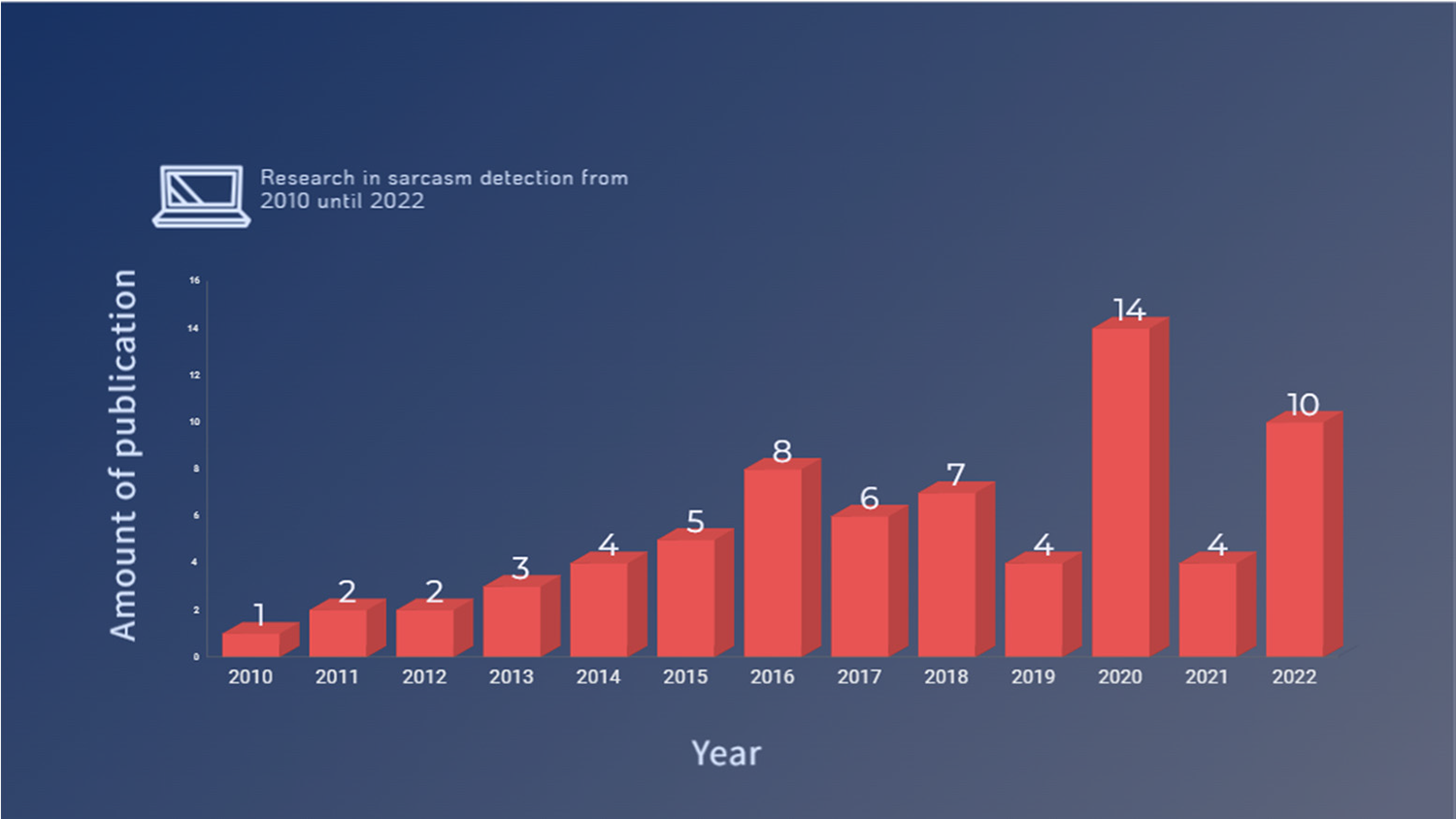
Figure 1: Sarcasm trend research from 2010 to 2022
While previous research efforts have employed a spectrum of methodologies, these endeavors predominantly fall within two overarching domains: machine learning and deep learning. Machine learning-based approaches have been explored utilizing techniques such as the Support Vector Machine (SVM) [6], Lexical influence [7], and the ensemble method of SVM, K-Nearest Neighbor (KNN), and decision tree [8].
However, traditional machine learning approaches have exhibited limitations when confronted with sarcastic statements carrying implicit messages, as they struggle to contextualize the sentence as a whole. This necessitated a transition towards deep learning methods. Subsequently, research has embraced a deep learning paradigm for sarcasm classification, incorporating techniques such as multi-layer perceptrons [9] and hybrid neural networks that combine Convolutional Neural Networks (CNN) and bidirectional Long Short Term Memory (LSTM) architectures [10]. While these endeavors have primarily focused on model development, this research endeavors to bridge the gap by exploring and developing augmentation techniques tailored specifically for sarcasm data.
Apart from advancing deep learning model methodologies, this research acknowledges the significance of data augmentation in enhancing a model’s classification capability. Existing research has explored a range of data augmentation techniques to improve model performance in sarcasm detection. However, one relatively uncharted avenue within the realm of sarcasm text augmentation is the application of Generative Adversarial Networks (GANs). GAN-based augmentation has yielded satisfactory results in image-processing domains such as medical imaging [11], face detection [12], and agriculture [13]. Nevertheless, its potential in sarcasm text augmentation remains underexplored.
Inspired by the success of GANs in augmenting datasets, this research introduces a novel framework employing the Reverse Generative Adversarial Neural Network (RGAN) technique. This framework aims to enhance the accuracy of deep learning models in sarcasm detection. The fundamental premise of RGAN involves reversing the labels of genuine and synthetic data. This reversal encourages the generator to produce data closely resembling real data while challenging the discriminator to develop a more comprehensive understanding of subtle distinctions between authentic and synthetic data.
In summary, the contributions of this research encompass:
• The author’s proposed framework introduces a novel approach for enhancing sarcastic data through the utilization of a Reverse Generative Adversarial Network (RGAN). The purpose of reversing the labels of actual and fake data is to encourage the generator to produce data that closely resembles real data while simultaneously pushing the discriminator to develop a more comprehensive understanding of the subtle differences between real and fake data.
• The research involved the execution of tests and subsequent analysis to provide evidence supporting the effectiveness of data augmentation through the use of RGAN in enhancing the model’s ability to differentiate between sarcastic and non-sarcastic texts. This was compared to the alternative methods of synonym replacement in NLPAug and the traditional GAN method. Then, This research also analyses the distribution of data generated from GAN-based models.
• Performed RGAN testing on balanced and unbalanced datasets. Tests were conducted with 4 augmentation scenarios on each dataset based on percentages of 15%, 30%, and 45% and adjusting the number of data additions with the highest class. To analyze GAN’s efficiency further, this research also analyses the distribution of data generated from GAN-based models.
The remainder of this paper is structured as follows: Section 2 reviews previous research on sarcasm detection and augmentation techniques in sarcasm datasets. Section 3 goes over the datasets used, pre-processing techniques, proposed models, and experimental methods. Session 4 explains the data generated by GAN as well as the experimental results. Finally, in Session 5, the conclusions of this research are discussed.
In this session, we will discuss previous research in detecting sarcasm and augmentations used in text data. The summary of previous research shown in Table 1 shows that sarcasm sentence research tends to explore less data augmentation.
2.1 Sarcasm Detection with Machine Learning
Previous studies have explored the detection of sarcasm through the utilization of multiple machine learning models, which are combined utilizing ensemble learning techniques [8]. The dataset utilized in this study was sourced from the Twitter social media platform, comprising instances that were classified as either sarcasm or non-sarcasm. Ensemble learning encompasses various combinations of models. In a general sense, an ensemble learning approach that incorporates Support Vector Machines (SVM), Logistic Regression (LR), and Decision Trees (DT), utilizing a voting system to determine class prediction, demonstrates superior average accuracy performance when evaluated on five distinct datasets, surpassing alternative ensemble models. The Principal Component Analysis (PCA) algorithm for dimension reduction is utilized in order to represent numerous features through a decreased feature dimension in the experiments. The ensemble learning of Support Vector Machines (SVM), Linear Discriminant Analysis (LD), and Decision Trees (DT) achieved an accuracy of 98.37% on the evaluated dataset. While Support Vector Machines (SVM), Logistic Regression (LR), and Decision Trees (DT) are capable of identifying the relationship between words in a phrase, it should be noted that typical LR models are not specifically designed to handle sequential data, such as text. Traditional machine learning (ML) methods also exhibit inadequate capability in comprehending context, resulting in a failure to grasp semantic links between words. This phenomenon has the potential to result in misclassification or the occurrence of false positives.
In the same year, a study conducted by Godara et al. [8] yielded findings that were consistent with the prior research. Nevertheless, the current study does not employ an ensemble learning methodology and conducts the classification procedure separately for each model [14]. The dataset was obtained by utilizing an Application Programming Interface (API) provided by Twitter. Specifically, comments containing the hashtag #sarcasm were selected, resulting in a dataset comprising a total of 76,799 tweets. The experimental findings indicate that the Decision Tree algorithm achieves the highest level of accuracy, specifically 91.84%. This outcome is attributed to the utilization of the sarcastic feature set, which comprises various linguistic elements associated with sarcasm, including question marks, exclamation marks, and repeated ellipses. The feature set for sarcasm detection includes both positive and negative sentiment data as additional evidence for identifying sarcastic sentences.
Previous studies have employed a rule-based approach to identify ironic statements, a specific form of sarcasm [15]. The dataset employed in this study is derived from SemEval 2018-T3, which consists of phrases that exhibit irony. The SVM, Naive Bayes, Decision Tree, and Random Forest algorithms are enhanced by the utilization of rule-based lexical and semantic techniques. These techniques serve to eliminate irrelevant words and assess the level of sarcasm, thus improving the ability to recognize contextual information within a phrase. The Random Forest algorithm yields the most accurate results.
2.2 Sarcasm Detection with Deep Learning
There have been studies to detect sarcasm in texts. Recognizing the form of sarcasm in a text is very useful for analyzing customer satisfaction and providing the right steps for making business decisions. However, detecting sarcasm remains difficult, particularly in understanding the context of a sarcastic sentence. There are researchers who use multi-head attention on bidirectional LSTM to detect sarcasm [17]. The private dataset utilized is a collection of comments that include quotation marks, exclamation points, and a mix of question marks and exclamation points. These characteristics are thought to be able to aid the model in identifying the context of sarcasm. Meanwhile, the bidirectional LSTM has forward and backward modes to capture all of the information from a sentence. With multi-head attention, which gives each word a different weight, it is possible to understand the relationship between complex words [21]. Compared to SVM and bidirectional without multi-head attention in this study, multi-head attention mixed with bidirectional LSTM performs better because it can capture word context. Despite the use of an attention mechanism in this research, the model has an accuracy of less than 80%. Regardless of the fact that the dataset used has features such as the number of quotes, exclamation marks, question marks, ellipses, and interjections, this research does not investigate dataset augmentation.
Using C-Net, there is research on how to categorize sarcasm and non-sarcasm [16]. C-Net is composed of many Bidirectional Encoder Representation from Transformers (BERT) models that are trained independently on the response data, the last sentence of the context set, the second last sentence of context, and the first sentence of context, and are then integrated at the fusion layer. BERT [22] is a highly effective natural language understanding model. BERT can read sentences from left to right and vice versa in order to better understand the context of the sentence as a whole. Some words from the dataset will be masked during the tokenization process, and the model will make efforts to guess these words based on the unmasked words. Aside from that, BERT can predict subsequent sentences. The C-Net model experiment makes use of dialog-sentence-formatted datasets from Twitter and Reddit. Sentences in the text are marked sequentially using timestamping. Overall, this study contrasts traditional machine learning with a transformer-based approach. According to the results, the transformer model outperforms all traditional machine learning methods, with F1-scores of 75% and 66.3% on the Twitter and Reddit datasets, respectively. Similarly to previous studies by [17], the research did not investigate dataset augmentation. The dataset used is quite small, with less than 10,000 data points for Twitter and Reddit.
Research on sarcasm detection using a hybrid neural network consisting of CNN and Bidirectional LSTM with an attention module has been carried out [10]. CNN can benefit from input encoded from LSTM by spotting n-gram word patterns. Due to the weighting provided by the attention module, the model can then better understand the context of a word. Using the attention module, CNN hybrid architecture and Bidirectional LSTM can detect incongruity in a sentence. The test accuracy obtained by comparing the baseline model and the intended method was 84.88% and 89.7%, respectively. Model development can significantly improve accuracy, but the quality of the model is not solely determined by the architecture. This research does not show the pre-processing side of the dataset used, and no dataset augmentation is explored.
2.3 Data Augmentation for Sarcasm Detection
Prior studies on the detection of sarcastic sentences have employed various techniques, such as augmenting existing sarcastic datasets by the incorporation of external datasets, utilizing word embedding methodologies, and employing sentence repetition [18]. The external dataset utilized is sourced from the Twitter social media network, as well as the SemEval-18 and ArSarcasm-v2 datasets. In contrast, the primary dataset included in this study is a proprietary dataset comprising sarcastic statements in both English and Arabic languages, with a total of 6570 and 4502 instances, respectively. The process of external dataset augmentation involves merging the original dataset with an external dataset in order to introduce a significant level of variability. Word embedding is a technique employed to substitute words within a sentence with synonymous alternatives. In order to get a balanced distribution of sardonic and non-sarcastic classes, the technique of repeating words is employed to replicate the same case. The accuracy of validation and tests has shown a significant disparity as a consequence of conducting experiments on three distinct augmentation techniques. Word embedding is a technique employed to substitute words within a sentence with their corresponding synonyms. In order to achieve a fair distribution of sarcastic and non-sarcastic classes, the technique of repeating sentences is employed to replicate instances of the same content. The accuracy of validation and tests has shown a significant disparity as a consequence of conducting experiments on three distinct augmentation techniques. Among the numerous experiments undertaken, it was seen that the BERT model, when augmented with the repetition of words, achieved a validation accuracy of 0.92. Additionally, when the model was tested using pre-processing techniques that involved converting emojis to strings, a test accuracy of 0.87 was obtained. Nevertheless, there are still symptoms of overfitting present in the model due to the possibility of the augmentation technique being excessively highlighted as a result of the frequent repetition of phrases. In contrast, the external dataset augmentation exhibited notable performance, achieving the highest validation and test accuracy scores of 0.41 and 0.07, respectively. Ultimately, the technique of synonym replacement augmentation demonstrated superior performance, achieving scores of 0.86 and 0.84, respectively. Excessive variance in the external dataset, as well as an overemphasis on certain elements, such as repeated words, might lead to overfitting of the model or a decline in its performance.
The model’s capacity to recognize sarcasm may be influenced by the data augmentation of sarcastic sentences [23]. Generative Adversarial Network (GAN) is a potential method for augmenting data. Common applications of GANs in the field of image augmentation include the generation of synthetic data with high levels of similarity to the original data. In this approach, synthetic data can be utilized to expand the range of the original dataset [24]. GAN technique paired with BERT is another method for performing data augmentation for text datasets [20]. Both labeled and unlabeled data are sent to BERT as input for vectorization. Meanwhile, the GAN generator reproduces false data derived from random distribution noise. The discriminator’s job is to distinguish between authentic and false data. Training continues until the discriminator is unable to distinguish between genuine and fraudulent data that has been reproduced by the generator. GAN-BERT was tested on two datasets: Stanford Sentiment Treebank with 5 different classes (SST-5) for sentiment analysis and Multi-Genre Natural Language Inference (MNLI) for natural language inference. GAN-results BERT’s improve accuracy by 8.2% on the SST-5 sentiment analysis dataset. There is evidence that using a smaller proportion of labeled data is more beneficial when using GAN-BERT. However, no tests of the fully labeled dataset in cases of sarcasm detection with more complex characteristics have been conducted.
Inverting class labels is another GAN technique [25]. Image data was used in the research. Typically, GAN trains the discriminator to distinguish between real and fake data and requires the generator to produce data that is as close to the original data as possible [26]. Reference [25], however, attempted to reverse the labels so that the discriminator can be viewed as a classifier that learns features from the original data. GANs that perform label inversion can learn more than just the difference between real and fake data. The research was successful in demonstrating another point of view through the use of GANs, but this technique still produces unstable results and has a chance of success only in certain cases.
Another research on data augmentation in sarcasm detection using the synonym replacement and duplication methods with NLPAug was done by [19]. The F1-score was evaluated using BERT, Robustly Optimized BERT Approach (RoBERTa) [27], and DistilBERT [28]. RoBERTa is a BERT-based model that has no next-sentence prediction (NSP) to predict a subsequent sentence prediction. Meanwhile, DistilBERT is a BERT model with smaller parameter values that is faster than BERT but has lower classification performance. The duplication augmentation technique improves performance on datasets iSarcasm [29], Ghosh et al. [30], and SemEval-18 [31]. The results obtained, however, demonstrate that augmentation data enhances model accuracy when it comes to non-sarcastic detection, as shown by an increase in true negatives.
According to previous works, performing augmentation on sarcasm data is challenging due to the unique complexity of the data. Meanwhile, in text data augmentation research, the GAN-based approach appears to be more promising than synonym replacement using NLPAug, repeating words, and external dataset augmentation, and there has been no text data research that used RGAN as a method of data augmentation. The performance of the model in detecting sarcasm is determined by the dataset, appropriate hyper-parameters, and appropriate model architecture. However, the main aim of this research is to propose a novel augmentation strategy for enhancing the sarcastic dataset through the utilization of Reverse Generative Adversarial Networks (RGAN). The characteristics of the data and the results of the sarcasm detection will be investigated thoroughly.
In this section, the methodological framework for investigating the effects of using Generative Adversarial Networks (GANs) for data augmentation in sarcasm detection is outlined. The methodology serves as the foundation upon which the selection of datasets and subsequent analysis is based.
This research utilizes four unique datasets to support theories and conduct an in-depth analysis of the effects of using GAN as a data augmentation. The dataset is divided into two categories: small (less than 10,000 sentences) and large (more than 30,000 sentences). This research uses iSarcasm [29] and SemEval [31] for small datasets. Each dataset has unique characteristics; for example, iSarcasm is a dataset obtained from Twitter via an online survey. Participants in survey responses provided sarcastic sentences and labels; this allows manual labeling techniques to be avoided because they cannot accurately determine sarcastic sentences from the perspective of the author of sarcasm sentences. In addition, this dataset has an unbalanced number of sarcastic and non-sarcastic. Unlike SemEval-18, this dataset has a relatively balanced combination of sarcastic and non-sarcastic words. SemEval-18 is a Twitter-sourced dataset. The data is labeled manually using a fine-grained annotation [32] scheme. The annotators are three linguistics students who speak English as a second language.
Ghosh et al. [30] was the dataset from the large category that was used in this research scenario. Ghosh is a Twitter dataset that contains sarcastic and non-sarcastic sentences. Sarcasm classes are collected by searching for the hashtag (#) sarcasm and #not. One example of a sarcastic sentence obtained by removing ‘#not’ is “I #not love when people start rumors about me.” It Becomes “I love it when people start rumors about me.” Meanwhile, when a sentence lacks a positive marker, it is classified as non-sarcastic. The obtained sentences are not in the form of lengthy conversations. Table 2 illustrates the size of the distribution of each class in the dataset used in detail.

3.2 Data Pre-Processing and Augmentation
Fig. 2 shows the data preprocessing scheme up to the input data to perform GAN data augmentation. All collected datasets undertake a cleaning process, such as URL links, hashtags, foreign languages, stop words, non-English ASCII characters, and emojis. After cleaning the dataset, an 80:20 splitting train and validation were performed for each dataset. Only the sarcasm class is used as input to the RGAN model. The main reason for augmentation in the sarcasm class is that sarcasm data is difficult to obtain [30], and augmenting the non-sarcastic class will only increase data inequality between classes. Furthermore, GAN is used on the dataset to perform unbalanced sarcasm data balancing. The augmentation process begins with the embedding process using DistilBERT, which is fed a dataset with only the sarcasm class as input. The generator then generates data in the form of noise from a random distribution. The discriminator uses word embedding and fake data from the generator to distinguish between real and fake data. As a result, the discriminator loss can be fed into the generator to generate data that is as close to the original data as possible. The data generated from the generator is in the form of features whose distribution results are close to the original data.

Figure 2: Data pre-processing stage
This research proposed a novel pipeline that would make use of GAN for data augmentation based on the Reverse GAN (RGAN) [25], which is commonly used with image data. Using a similar concept, and made several changes to accommodate the sarcasm data. Fig. 3 depicts a more detailed stage of the novel RGAN pipeline proposed. Sarcasm data that has been pre-processed will be used as input for embedding with distilBERT. The class used for embedding only contains fully labeled sarcasm classes. The main reasons for using only one class are: (1) Sarcasm data is difficult to obtain due to its high level of complexity, and (2) Balance sarcasm and non-sarcastic classes in each dataset used. The embedding process then utilizes pre-trained distilBERT, resulting in a high-quality embedding because the pre-trained distilBERT was trained on a large corpus of words. The result of the embedding is feature data, which is labeled as fake data. The original data is marked as fake data in the RGAN concept, and vice versa. As a result, the noise data generated by the generator is labeled as original data, so the discriminator must be certain that the data generated by the generator is real data, and the original data that is tagged false serves to cause the generator to produce data that is similar to but not an exact duplicate of the original data. The loss discriminator and generator are used as feedback for the generator to produce good data quality, with an indication that the lower the value of the loss generator and discriminator, the better the quality of the resulting data. The hyperparameter used is the learning rate of 0.001 as a result of hyperparameter parameter tuning in the generator and discriminator models and batch size of 16. This RGAN model also employs the Adam optimizer. The activation function used is the Rectified Linear Unit (ReLu). Instead of RGAN, we employ a standard GAN scheme that does not swap real and fake data labels. In the standard GAN, there are various indicators of a good model. For example, if the discriminator loss value is greater, it can indicate that the data generated by the generator is similar to the original data, and the discriminator is unsure whether the data is real or fake.
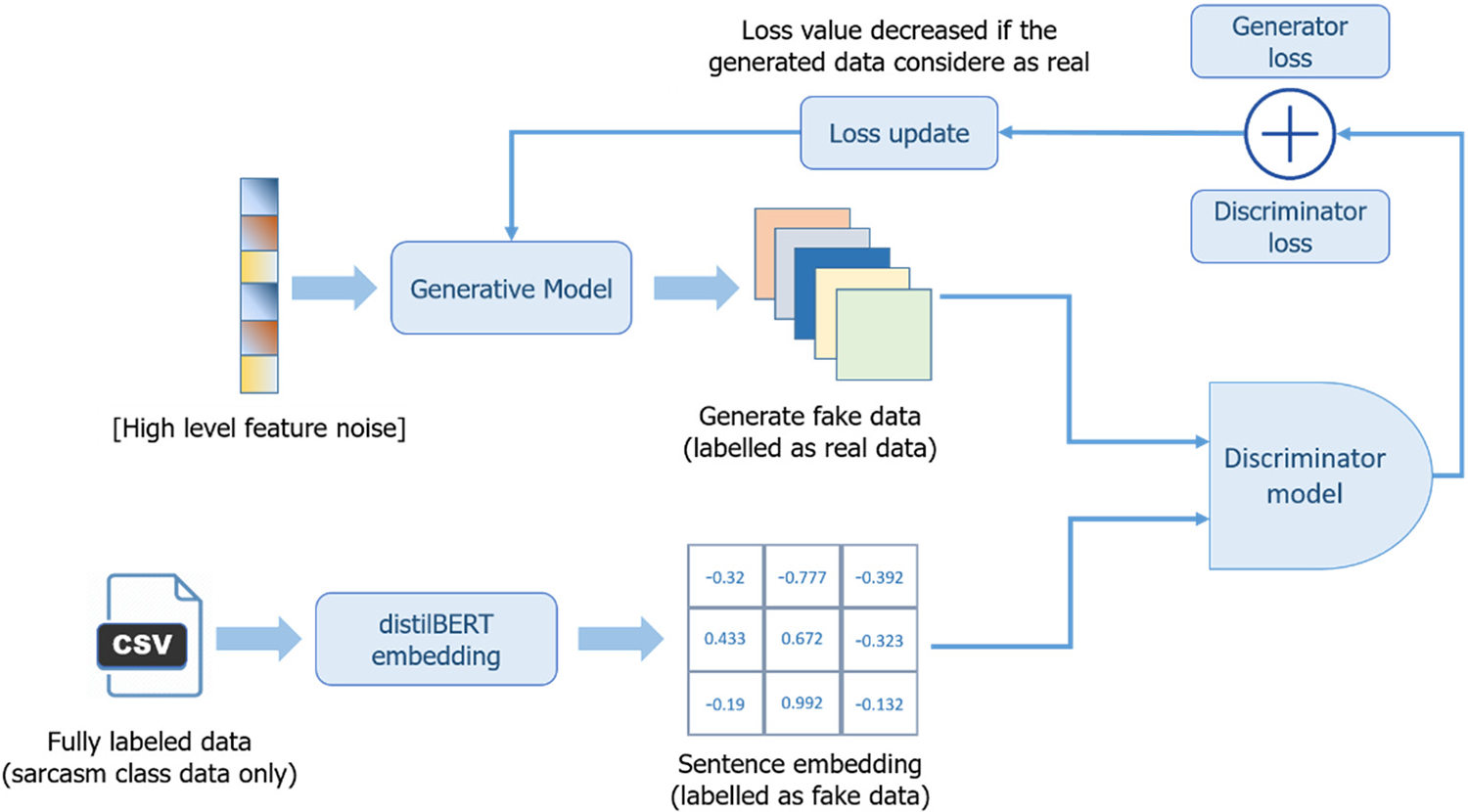
Figure 3: Proposed Reverse GAN (RGAN)
The generator’s new data is divided into three scenarios with data augmentation scales of 15%, 30%, and 45%. The generator’s synthetic data is combined with the original data as input for model training. The outcomes of each scenario will be compared to determine the GAN’s ability to detect sarcasm sentences. More detailed scenarios can be seen in Fig. 4.
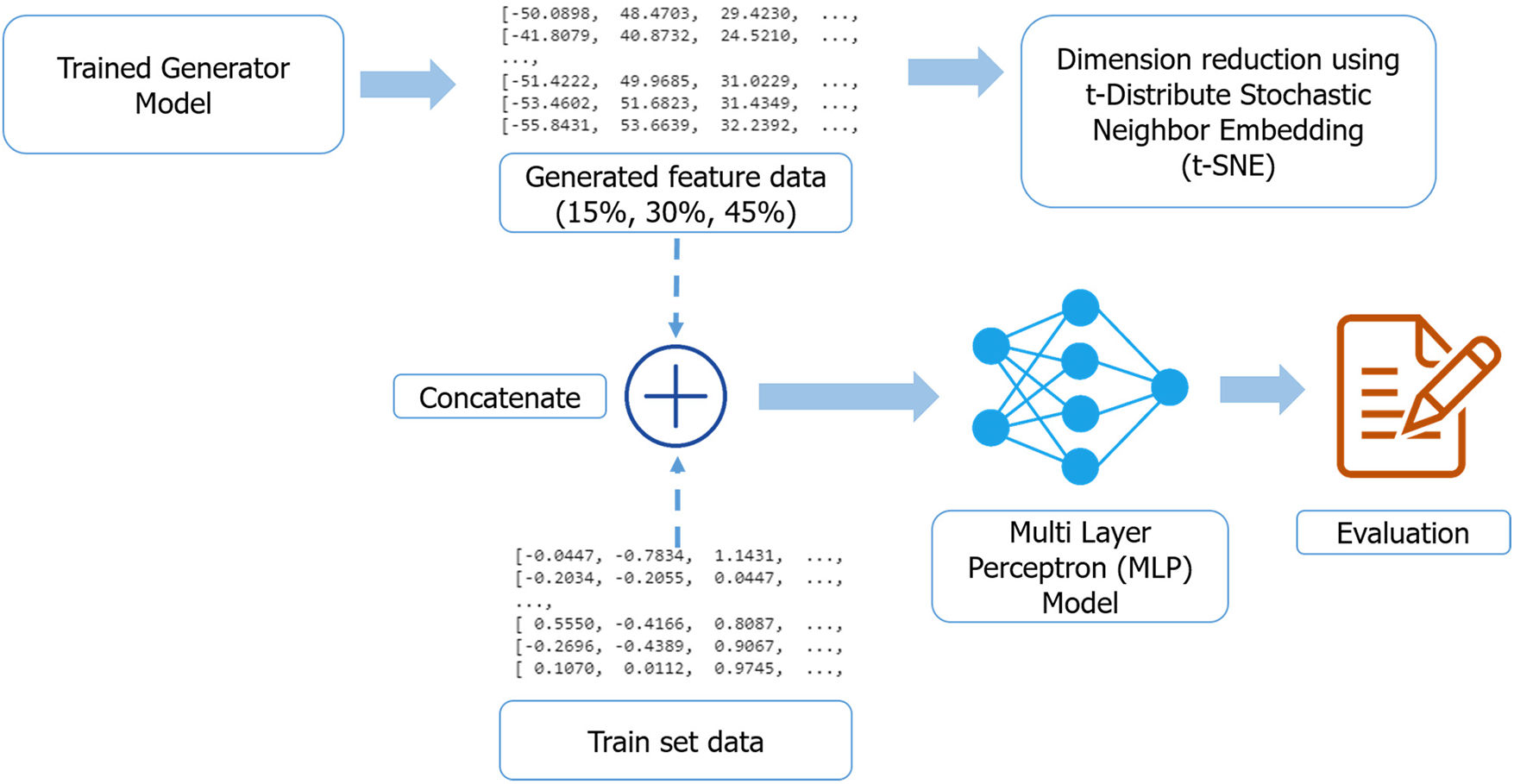
Figure 4: Model training with the data generated by the generator combined with the original data
The final evaluation results will compare the proposed RGAN model to the general GAN model. Aspects of the analysis performed, beginning with the quality of data analysis, the results of the resulting data distribution, and the effects observed when training with original data using the MLP model. Visualization is performed to analyze the data generated by RGAN by reducing the dimensions of the data. Because the characteristics of the RGAN data are quite complex, the t-Distribute Stochastic Neighbor Embedding (t-SNE) [33] algorithm was used to interpret the data visually. The t-SNE algorithm employs the following equation:
pi|j=exp(−‖xi−xj‖2/2σ2i)Σk≠iexp(−‖xi−xk‖2/2σ2i)(1)
qi|j=exp(−‖yi−yj‖2)Σk≠iexp(−‖xi−xk‖2)(2)
The Eq. (1) is used to determine the pairwise similarity of data points in high-dimensional space. It assigns a probability density to each pair of data points based on their Euclidean distance using a Gaussian kernel. Then, Eq. (2) is used to determine the similarity of data points in low-dimensional space. It assigns a probability density to each pair of data points using a Student’s t-distribution. Gradient descent is used iteratively to minimize Kullback–Leibler (KL) divergence by adjusting the position of the data distribution with the following Eq. (3):
δCδyi=2∑j(Pi|j−qi|j+Pi|j−qi|j)(yi−yj)(3)
Meanwhile, the Multi Layer Perceptron (MLP) model results from the F1-score and the MLP model loss will demonstrate validation of the quality of the data generated by the RGAN. The hyperparameter used in the MLP model is a learning rate of 0.0001 using the Adam optimizer, batch size 16, epoch 100, early stopping with large patience of 10 and a seed value of 200. The augmentation method with RGAN is compared with the augmentation method using the original GAN, where the labels of the original data and synthetic data are not reversed, and NLPAug, which is one of the popular augmentation frameworks on text data [34].
In this section, the results of the experiments are presented and discussed, focusing on the application of Generative Adversarial Networks (GANs) for data augmentation in sarcasm detection. The primary objective is to evaluate the impact of GAN-based augmentation on model performance, emphasizing the quality of augmented data and its effect on classification accuracy. The analysis begins with an evaluation of data quality following the GAN augmentation process. This evaluation employs loss values of the generator and discriminator as well as dimensionality reduction techniques to visualize the differences between real and synthetic data distributions. Subsequently, the discussion delves into the experimental results, comparing GAN augmentation with alternative techniques, such as NLPAug and unaugmented data. These experiments provide insights into the benefits and limitations of GAN augmentation, particularly in scenarios involving small datasets and class imbalance.
4.1 Augmented Data Quality Evaluation
Multidimensional features are utilized to store the information generated by the GAN generator. The evaluation of data quality takes place subsequent to data generation. Loss values from both the generator and discriminator serve as valuable indicators for assessing data quality. Furthermore, to gain deeper insights into the disparities between the distributions of real and synthetic data, the t-SNE technique is employed for dimensionality reduction. The results of this visualization technique are presented in Figs. 5–7.
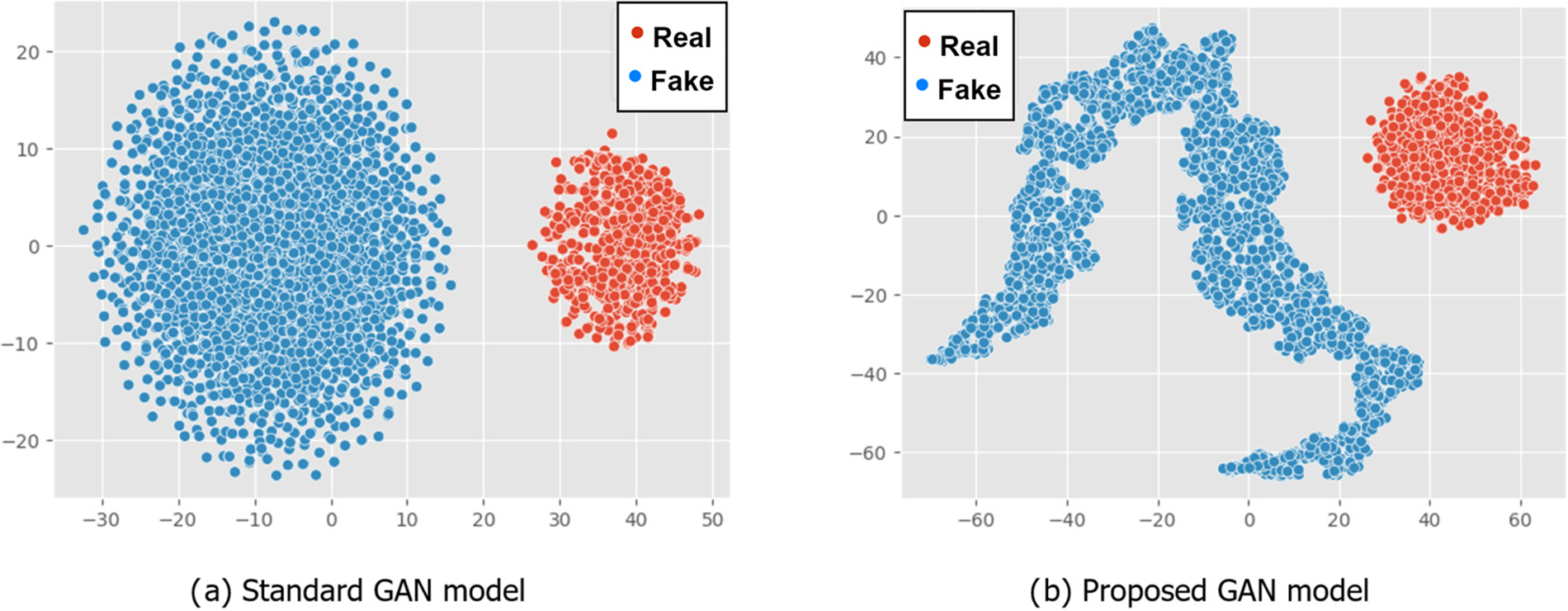
Figure 5: Generated data for iSarcasm dataset

Figure 6: Generated data for SemEval-18 dataset
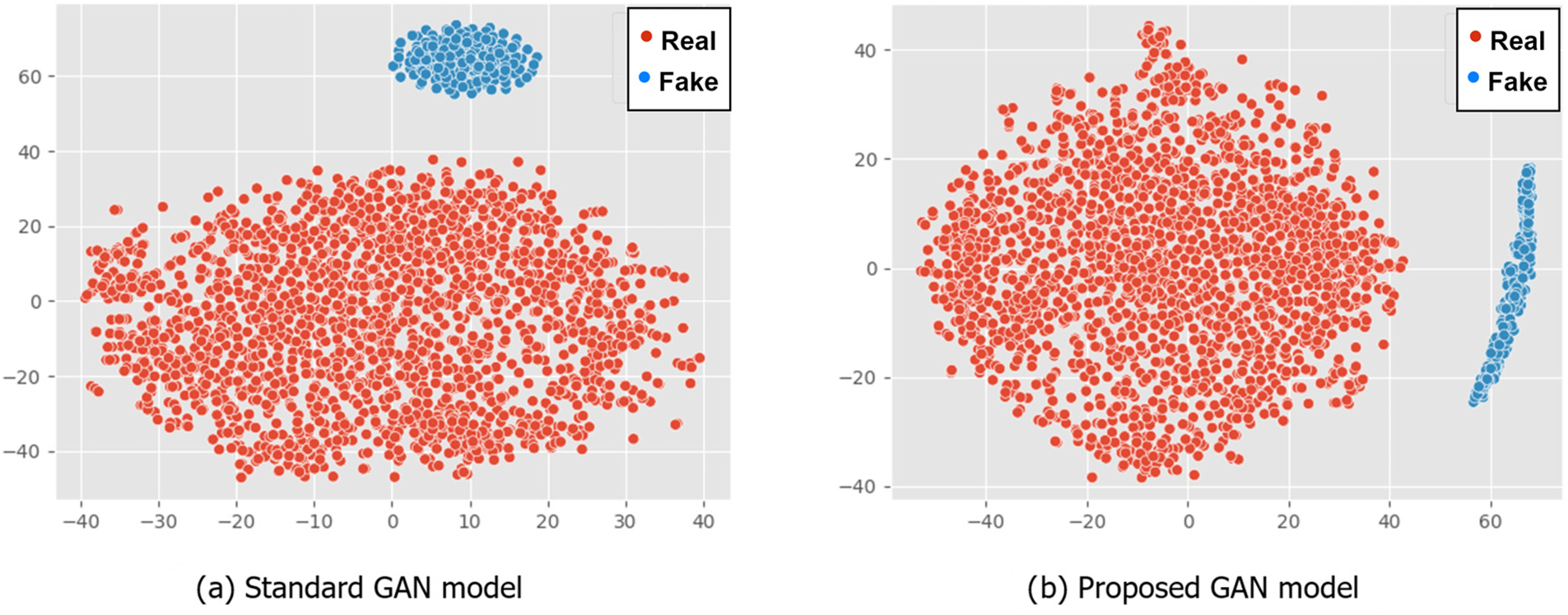
Figure 7: Generated data for Ghosh dataset
The resulting pattern shows the difference in data distribution between standard GAN and RGAN. The standard GAN tends to follow the original dataset’s pattern and has a more defined data center point, whereas the RGAN has a more varied pattern. Both types of GAN produce data that is close enough to the original data to be considered similar. However, if the resulting data exceeds the original data, the RGAN has a high level of outliers. For example, in Fig. 5b, the resulting data far outnumbers the original data. Meanwhile, the data distribution in Fig. 5a is more consistent. The amount of the learning rate has an impact on the data distribution distance produced by the Reverse Generative Adversarial Network (RGAN). A lower learning rate leads to a more realistic representation of the original data, which can introduce noise due to the duplication of several features. On the other hand, in the case of an excessively high learning rate, the resultant feature distance will be significantly greater, leading to an increased data variance that can result in overfitting [35]. Therefore, a learning rate of 0.001 is commonly employed in the Adam optimizer [36] to ensure that the data distribution remains suitably balanced in relation to the original feature.
In this section, the focus shifts to the discussion of experimental results and the ramifications of employing GAN augmentation. It is important to note that the dataset augmentation was exclusively applied to the sarcasm class. A comparative analysis is conducted, contrasting the outcomes of GAN augmentation with those of NLPAug and the original dataset. The data generated by the generator in GAN is in the form of a feature that approximates the distribution of sarcasm class features in the DistilBERT-encoded. Meanwhile, NLPAug replaces adjectives in the sarcasm class with synonyms and does not increase the amount of data. Figs. 8–10 are class distributions in each dataset used with changes in the amount of data in the sarcasm class after augmentation with GAN. Table 3 shows the results of experiments on the iSarcasm dataset. The obtained results show that the standard GAN with an augmentation percentage of 45% has the highest F1-score. When compared to RGAN, standard GAN has a more stable data distribution. Experiments on balanced GANs, on the other hand, show that the RGAN has a much higher value than the standard GAN. In the balanced sarcasm class experiment, data augmentation produced nearly 2.1 times fake data based on the original one. The data generated by the standard GAN has a noisy indication, which reduces accuracy. RGAN, on the other hand, has succeeded in producing more varied data, even though there are data points that are further away from the original data points, it does not make the data dirty. However, in order to obtain a low loss value and a high F1-score, the data generated by the reverse GAN must be adjusted to the original dataset. When compared to NLPAug, all augmentation data using GAN has a higher value, implying that GAN augmentation is appropriate for datasets with small amounts of data and unbalanced classes.
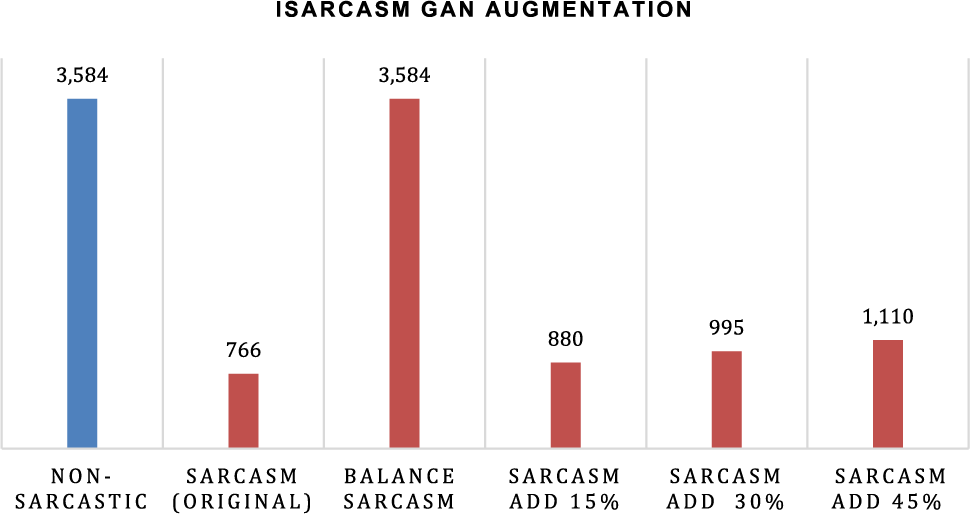
Figure 8: The difference in the amount of data in the sarcasm class in the iSarcasm dataset is based on the percentage of augmentation
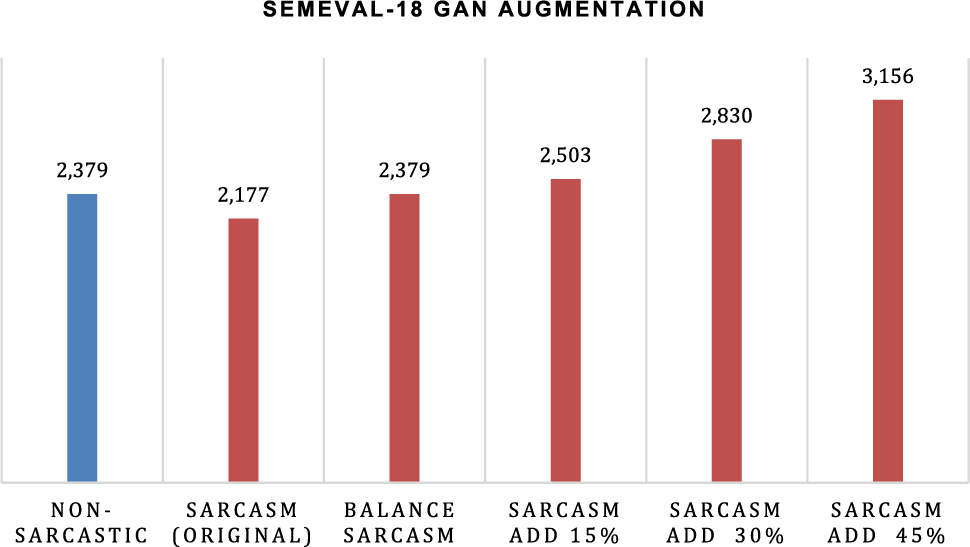
Figure 9: The difference in the amount of data in the sarcasm class in the SemEval-18 dataset is based on the percentage of augmentation
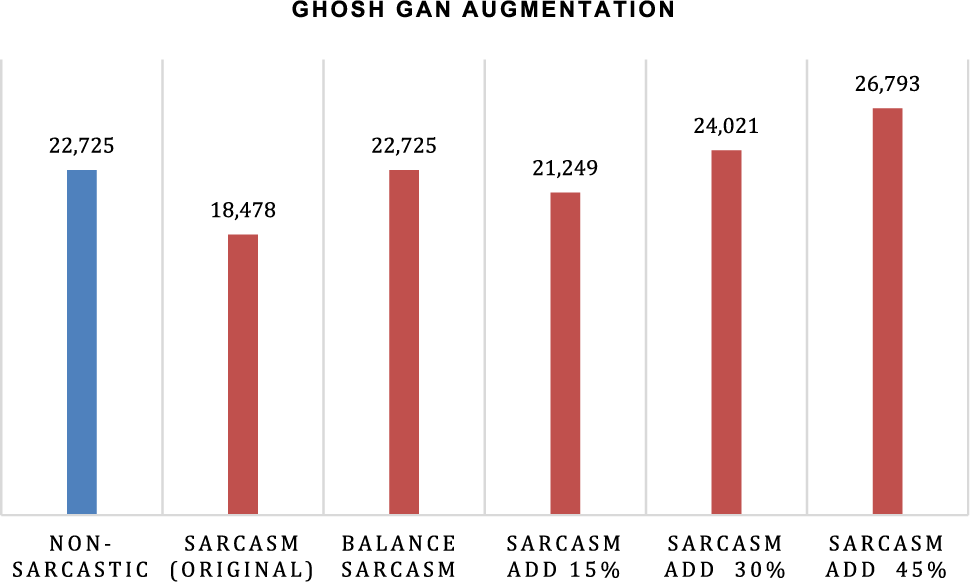
Figure 10: The difference in the amount of data in the sarcasm class in the Ghosh dataset is based on the percentage of augmentation

Experiments with the SemEval-18 dataset yielded the same results in Table 4. Standard GAN has the highest F1-score and the lowest validation loss, implying that GAN augmentation is also suitable for small datasets but has a balanced class. However, if the data generated by GAN causes an imbalance between classes, the accuracy tends to decrease, as in the case of the addition of 45% data, where the sarcastic data far outnumbers the non-sarcastic data. Unlike iSarcasm, the SemEval-18 dataset shows a better GAN standard under balanced sarcasm class conditions because the resulting data is still within reasonable limits below 15%. Meanwhile, the results of data augmentation with NLPAug did not increase the F1-score and tended to decrease the F1-score so that it could be indicated if NLPAug caused noise in the data.

Table 5 shows that augmentation with RGAN has the highest F1-score, at 69.01%, based on experiments on the Ghosh dataset. Balance class is a dataset that contains non-sarcastic numbers with balanced sarcasm and non-sarcastic classes of 22,725 and 22,725 sarcasm. With a relatively balanced distribution of data for each class in the SemEval-18 and Ghosh datasets, it has the consistency that if the augmentation data of the sarcastic class far exceeds the non-sarcastic class, the accuracy will tend to decrease. In a balanced class condition, the RGAN has a better F1-score, so it shows the same indication as the iSarcasm dataset. Augmentation with a standard GAN yields similar results to augmentation with an RGAN. NLPAug also produces results that are consistent with lower values than GAN augmentation.

In general, the proposed data augmentation in this research differs from GAN-BERT. The data generated by the generator is only used as input to the discriminator in GAN-BERT, so it is unclear whether changes in accuracy in classifying sarcasm data are used when using GAN or not. Meanwhile, the generator that is used to generate new data will be filled into the model as input as features with data points that are similar to the original data, with the goal of evaluating the quality of the resulting data. GAN-BERT uses unlabeled labels as supporting data for unbalanced classes on the generator to balance unbalanced data. However, using an excessive amount of unlabeled data may cause the generator to produce data in a balanced class, allowing data to become even more unbalanced. Consequently, the approach here is to train the GAN model with data from unbalanced classes. All experiments showed that GAN-based augmentation improved the model’s ability to classify sarcasm compared to NLPAug. Data augmented with NLPAug does not generate new data, so there is still an imbalance between classes. NLPAug is better suited for adding variety to balanced datasets like Ghosh. NLPAug does not improve at all on unbalanced datasets like iSarcasm.
A comparison and discussion between this research and other works in implementing data augmentation can be seen in Table 6.

In comparison to the studies presented in Table 6, this research offers a distinct and superior approach to sarcasm detection through Generative Adversarial Networks (GANs) for data augmentation. While the mentioned studies have primarily focused on external datasets, synonym replacement, or simple augmentation techniques, our research introduces a novel framework utilizing Reverse GAN (RGAN) in the context of sarcasm detection. The results of our experiments on datasets like iSarcasm, SemEval-18, and Ghosh showcase the efficacy of GAN-based augmentation, particularly when the synthetic data closely aligns with the volume of the original data. Notably, our approach outperforms NLPAug in scenarios with small datasets and class imbalances. Moreover, we demonstrate that RGAN, a less common technique, can achieve performance results comparable to those of standard GAN. The ability to generate synthetic text data that closely matches the original data in features sets our research apart, offering a more balanced and effective approach to augmenting text data for sarcasm detection. This research emphasizes the versatility and effectiveness of the RGAN technique, providing a robust solution for improving sarcasm detection accuracy in diverse augmentation scenarios.
1. The successful application of the suggested novel framework for enhancing text data through the incorporation of additional data features has been demonstrated in its ability to enhance the performance of the model in identifying sarcasm within specific augmentation scenarios.
2. Due to the different characteristics of each dataset, GAN-based augmentation in different datasets could have a different impact on performance. Overall, based on the analysis, it is found that if the synthetic data does not exceed the amount of original data, GAN-based augmentation can improve performance significantly when compared to using NLPAug.
3. The utilization of the Reverse GAN technique, although not commonly practiced, delivered performance outcomes in sarcasm detection that are on par with those achieved using the standard GAN.
In conclusion, this study has introduced a novel framework for enhancing text data through the incorporation of additional data features, demonstrating its success in improving model performance in sarcasm detection within specific augmentation scenarios. This study revealed that the impact of GAN-based augmentation on performance varies across datasets, with a consistent finding that GAN-based augmentation outperforms NLPAug when synthetic data does not significantly exceed the volume of original data. One of the key contributions of this research is the utilization of the Reverse GAN (RGAN) technique, a less common approach, which yielded performance results in sarcasm detection comparable to those achieved using the standard GAN. This suggests the effectiveness and versatility of RGAN in enhancing text data.
Augmentation with GAN in the sarcasm class tends to lose accuracy if the data generated far exceeds that of the non-sarcastic class. Meanwhile, if the augmentation in the sarcasm class produces data that is many times the size of the original data, using an RGAN, as in the iSarcasm dataset, will be more profitable. The SemEval-18 dataset yields the opposite result, demonstrating that using standard GANs is more advantageous when adding data reaches a balance point. However, the Ghosh dataset demonstrates that a relatively balanced dataset does not necessitate a large amount of synthetic data. This is because Tables 3 and 4 show that the best augmentation results were obtained in experiments with generated data less than 45%. Because of the relatively high level of difficulty, the future research potential for augmenting text datasets is still very broad. Producing synthetic text data in the form of text (rather than features) is a challenging task. Currently, the Reverse Generative Adversarial Network (RGAN) lacks the capability to reconstruct feature forms into textual representations. Another challenge is the development of transformer models capable of reading input in the form of features; there are currently only a few state-of-the-art models capable of receiving input data in the form of features.
Acknowledgement: None.
Funding Statement: The authors received no specific funding for this study.
Author Contributions: Study conception and design: Derwin Suhartono; data collection: Derwin Suhartono, Alif Tri Handoyo; analysis and interpretation of results: Franz Adeta Junior, Alif Tri Handoyo; draft manuscript preparation: Franz Adeta Junior. All authors reviewed the results and approved the final version of the manuscript.
Availability of Data and Materials: All dataset in this paper is publicly available in GitHub repositories. For iSarcasm dataset (https://anonymous.4open.science/r/24639225-ac0e-4057-b2d4-16e7e50570d0/README.md), SemEval-2018 (https://github.com/Cyvhee/SemEval2018-Task3), and Ghosh (https://github.com/MirunaPislar/Sarcasm-Detection).
Conflicts of Interest: The authors declare that they have no conflicts of interest to report regarding the present study.
References
1. C. I. Eke, A. A. Norman, L. Shuib and H. F. Nweke, “Sarcasm identification in textual data: Systematic review, research challenges and open directions,” Artificial Intelligence Review, vol. 53, no. 6, pp. 4215–4258, 2020. [Google Scholar]
2. S. Frenda, A. T. Cignarella, V. Basile, C. Bosco, V. Patti et al., “The unbearable hurtfulness of sarcasm,” Expert Systems with Applications, vol. 193, pp. 116398, 2022. https://doi.org/10.1016/j.eswa.2021.116398 [Google Scholar] [CrossRef]
3. S. M. Sarsam, H. Al-Samarraie, A. I. Alzahrani and B. Wright, “Sarcasm detection using machine learning algorithms in Twitter: A systematic review,” International Journal of Market Research, vol. 62, no. 5, pp. 578–598, 2020. [Google Scholar]
4. S. K. Bharti, B. Vachha, R. K. Pradhan, K. S. Babu and S. K. Jena, “Sarcastic sentiment detection in tweets streamed in real time: A big data approach,” Digital Communications and Networks, vol. 2, no. 3, pp. 108–121, 2016. [Google Scholar]
5. A. C. Băroiu and Ș. T. Matu, “Automatic sarcasm detection: Systematic literature review,” Information, vol. 13, no. 8, pp. 1–17, 2022. [Google Scholar]
6. A. Joshi, V. Tripathi, K. Patel, P. Bhattacharyya and M. Carman, “Are word embedding-based features useful for sarcasm detection?” in Proc. of 2016 Conf. on Empirical Methods in Natural Language Processing, Austin, Texas, pp. 1001–1006, 2013. [Google Scholar]
7. R. J. Kreuz and G. M. Caucci, “Lexical influences on the perception of sarcasm,” in Proc. of Workshop on Computational Approaches to Figurative Language, Rochester, New York, USA, pp. 1–4, 2007. [Google Scholar]
8. J. Godara, I. Batra, R. Aron and M. Shabaz, “Ensemble classification approach for sarcasm detection,” Behavioural Neurology, 2021. https://doi.org/10.1155/2021/9731519 [Google Scholar] [PubMed] [CrossRef]
9. J. Lemmens, B. Burtenshaw, E. Lotfi, I. Markov and W. Daelemans, “Sarcasm detection using an ensemble approach,” in Proc. of Second Workshop on Figurative Language Processing, Online, pp. 264–269, 2020. [Google Scholar]
10. R. Misra and P. Arora, “Sarcasm detection using hybrid neural network,” arXiv:1908.07414, 2019. [Google Scholar]
11. N. K. Singh and K. Raza, “Medical image generation using generative adversarial networks: A review,” Studies in Computational Intelligence, vol. 932, pp. 77–96, 2021. [Google Scholar]
12. J. Choe, S. Park, K. Kim, J. H. Park, D. Kim et al., “Face generation for low-shot learning using generative adversarial networks,” in Proc. of IEEE Int. Conf. on Computer Vision Workshops, Venice, Italy, pp. 1940–1948, 2017. [Google Scholar]
13. Y. Lu, D. Chen, E. Olaniyi and Y. Huang, “Generative Adversarial Networks (GANs) for image augmentation in agriculture: A systematic review,” Computers and Electronics in Agriculture, vol. 200, pp. 107208, 2022. [Google Scholar]
14. A. Rahaman, R. Kuri, S. Islam, M. J. Hossain and M. H. Kabir, “Sarcasm detection in tweets: A feature-based approach using supervised machine learning models,” International Journal of Advanced Computer Science and Applications, vol. 12, no. 6, pp. 454–460, 2021. [Google Scholar]
15. K. Sentamilselvan, P. Suresh, G. K. Kamalam, S. Mahendran and D. Aneri, “Detection on sarcasm using machine learning classifiers and rule based approach,” in IOP Conf. Series: Materials Science and Engineering, Erode, India, vol. 1055, no. 1, pp. 012105, 2021. [Google Scholar]
16. A. K. Jena, A. Sinha and R. Agarwal, “C-Net: Contextual network for sarcasm detection,” in Proc. of Second Workshop on Figurative Language Processing, Kochi, Kerala, India, pp. 61–66, 2020. [Google Scholar]
17. A. Kumar, V. T. Narapareddy, V. A. Srikanth, A. Malapati and L. B. M. Neti, “Sarcasm detection using multi-head attention based bidirectional LSTM,” IEEE Access, vol. 8, pp. 6388–6397, 2020. [Google Scholar]
18. M. Shaheen and S. K. Nigam, “Plumeria at SemEval-2022 Task 6: Sarcasm detection for English and Arabic using transformers and data augmentation,” in Proc. of 16th Int. Workshop on Semantic Evaluation (SemEval-2022), Seattle, USA, vol. 6, pp. 923–937, 2022. [Google Scholar]
19. A. T. Handoyo, H. Hidayaturrahman, C. J. Setiadi and D. Suhartono, “Sarcasm detection in twitter—Performance impact while using data augmentation: Word embeddings,” International Journal of Fuzzy Logic and Intelligent Systems, vol. 22, no. 4, pp. 401–413, 2022. [Google Scholar]
20. D. Croce, G. Castellucci and R. Basili, “GAN-BERT: Generative adversarial learning for robust text classification with a bunch of labeled examples,” in Proc. of 58th Annual Meeting of the Association for Computational Linguistics, pp. 2114–2119, 2020. [Google Scholar]
21. A. Vaswani, N. Shazeer, N. Parmar, J. Uszkoreit, L. Jones et al., “Attention is all you need,” in Proc. of 31st Conf. on Neural Information Processing Systems, Long Beach, CA, USA, pp. 5999–6009, 2017. [Google Scholar]
22. J. Devlin, M. W. Chang, K. Lee and K. Toutanova, “BERT: Pre-training of deep bidirectional transformers for language understanding,” in Proc. of North American Chapter of the Association for Computational Linguistics, Minneapolis, Minnesota, USA, vol. 1, pp. 4171–4186, 2019. [Google Scholar]
23. H. Lee, Y. Yu and G. Kim, “Augmenting data for sarcasm detection with unlabeled conversation context,” in Proc. Second Workshop on Figurative Language Processing, pp. 12–17, 2020. [Google Scholar]
24. A. Creswell, T. White, V. Dumoulin, K. Arulkumaran, B. Sengupta et al., “Deep learning for visual understanding: Part 2 generative adversarial networks,” IEEE Signal Process Magazine, vol. 35, no. 1, pp. 53–65, 2018. [Google Scholar]
25. R. M. Weber, “Exploiting the hidden tasks of GANs: Making implicit subproblems explicit,” arXiv:2101.11863, 2021. [Google Scholar]
26. I. J. Goodfellow, J. P. Abadie, M. Mirza, B. Xu, D. W. Farley et al., “Generative adversarial networks,” Communications of the Association for Computing Machinery, vol. 63, no. 11, pp. 139–144, 2020. [Google Scholar]
27. Y. Liu, M. Ott, N. Goyal, J. Du, M. Joshi et al., “RoBERTa: A robustly optimized BERT pretraining approach,” arXiv:1907.11692, 2019. [Google Scholar]
28. V. Sanh, L. Debut, J. Chaumond and T. Wolf, “DistilBERT, a distilled version of BERT: Smaller, faster, cheaper and lighter,” arXiv:1910.01108, 2019. [Google Scholar]
29. S. V. Oprea and W. Magdy, “iSarcasm: A dataset of intended sarcasm,” in Proc. of the 58th Annual Meeting of the Association for Computational Linguistics, Online, pp. 1279–1289, 2020. [Google Scholar]
30. A. Ghosh and T. Veale, “Fracking sarcasm using neural network,” in Proc. of the 7th Workshop on Computational Approaches to Subjectivity, Sentiment and Social Media Analysis, San Diego, California, USA, pp. 161–169, 2016. [Google Scholar]
31. C. van Hee, E. Lefever and V. Hoste, “SemEval-2018 Task 3: Irony detection in English tweets,” in Proc. of the 12th Int. Workshop on Semantic Evaluation, New Orleans, Louisiana, USA, pp. 39–50, 2018. [Google Scholar]
32. C. Van Hee, E. Lefever and V. Hoste, “Guidelines for annotating irony in social media text, version 2.0,” LT3 Technical Report Series, 2016. https://lt3.ugent.be/media/uploads/publications/2015/annotation_guidelines_irony.pdf (accessed on 18/01/2023) [Google Scholar]
33. C. R. G. Alonso, L. M. P. Naranjo and J. C. F. Caballero, “Multiobjective evolutionary algorithms to identify highly autocorrelated areas: The case of spatial distribution in financially compromised farms,” Annals of Operations Research, vol. 219, no. 1, pp. 187–202, 2014. [Google Scholar]
34. B. Li, Y. Hou and W. Che, “Data augmentation approaches in natural language processing: A survey,” AI Open, vol. 3, pp. 71–90, 2022. [Google Scholar]
35. J. Lever, M. Krzywinski and N. Altman, “Points of significance: Model selection and overfitting,” Nature Methods, vol. 13, no. 9, pp. 703–704, 2016. [Google Scholar]
36. D. P. Kingma and J. L. Ba, “Adam: A method for stochastic optimization,” in Proc. of 3rd Int. Conf. on Learning Representations, San Diego, CA, USA, pp. 1–15, 2015. [Google Scholar]
Cite This Article
 Copyright © 2023 The Author(s). Published by Tech Science Press.
Copyright © 2023 The Author(s). Published by Tech Science Press.This work is licensed under a Creative Commons Attribution 4.0 International License , which permits unrestricted use, distribution, and reproduction in any medium, provided the original work is properly cited.


 Submit a Paper
Submit a Paper Propose a Special lssue
Propose a Special lssue View Full Text
View Full Text Download PDF
Download PDF
 Downloads
Downloads
 Citation Tools
Citation Tools